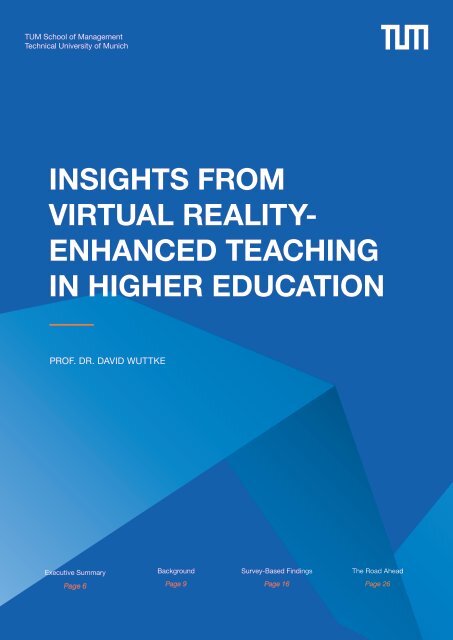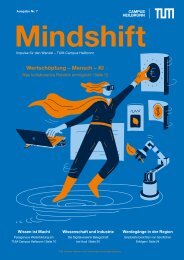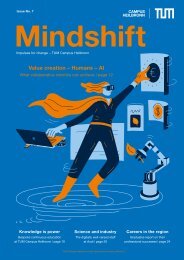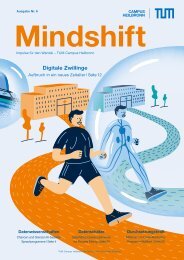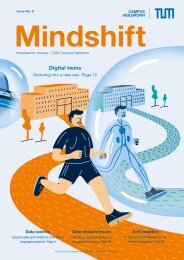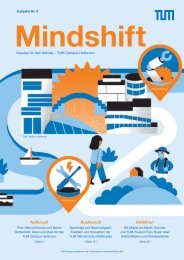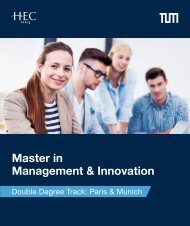You also want an ePaper? Increase the reach of your titles
YUMPU automatically turns print PDFs into web optimized ePapers that Google loves.
TUM School of Management<br />
Technical University of Munich<br />
INSIGHTS FROM<br />
VIRTUAL REALITY-<br />
ENHANCED TEACHING<br />
IN HIGHER EDUCATION<br />
PROF. DR. DAVID WUTTKE<br />
Executive Summary<br />
Background<br />
Survey-Based Findings<br />
The Road Ahead<br />
Page 6<br />
Page 9<br />
Page 16<br />
Page 26
White Paper: <strong>Teaching</strong> in <strong>Virtual</strong> <strong>Reality</strong><br />
EDITORIAL<br />
WELCOME FROM THE DEAN<br />
For years, digitalization in teaching has been a hot topic at universities,<br />
and the pandemic has given it an unexpected boost. This also applies to<br />
the TUM School of Management, which sees technology-<strong>enhanced</strong><br />
learning as an important development in its teaching activities.<br />
Put simply, technology-<strong>enhanced</strong> learning (TEL) seeks to maximize the student<br />
learning experience by using technology. It is transforming and enhancing<br />
education and educational institutions globally. As a school, we have<br />
committed to fostering the use of TEL in our TUM School of Management<br />
Strategy 2026 in order to improve the digital experience for our faculty and<br />
students. We plan to establish a minimum level of technology-<strong>enhanced</strong><br />
learning in all of our programs and make TEL the standard in all modules. To<br />
foster the needs of our students and the innovative elements of our programs,<br />
we will use an intelligent mix of on-site, online, and hybrid teaching.<br />
As a lab for developing innovative approaches to education, TUM Campus<br />
Heilbronn has been pioneering the use of virtual reality (VR) in teaching as an<br />
alternative and unique way for students and professors to interact and collaborate<br />
digitally. VR offers a highly immersive environment with a clear focus on<br />
content. This white paper furthermore depicts how students are benefiting from<br />
the VR experience, identifies areas of improvement, and provides an insightful<br />
outline of how the use of VR in higher education can succeed.<br />
I would like to thank David Wuttke for taking advantage of the many opportunities<br />
at the TUM Campus Heilbronn to initiate new approaches in teaching and<br />
congratulate him on the successful use of <strong>Virtual</strong> <strong>Reality</strong>.<br />
Prof. Dr. Gunther Friedl<br />
Dean of TUM School of Management<br />
Source: TUM School of Management<br />
PROF. DR. GUNTHER FRIEDL<br />
Dean of TUM School of Management<br />
2 3
White Paper: <strong>Teaching</strong> in <strong>Virtual</strong> <strong>Reality</strong><br />
EDITORIAL<br />
WELCOME FROM THE AUTHOR<br />
<strong>Virtual</strong> <strong>Reality</strong> (VR) has great potential, which is still vastly untapped in<br />
management education. The COVID-19 pandemic forced us to teach<br />
remotely and search for meaningful alternatives to online video communication<br />
tools. Our team explored the use of a virtual classroom environment<br />
in two courses in the summer term of 2021. In our solution, students<br />
and faculty were represented by avatars and communicated in a digital<br />
representation of a real classroom.<br />
Why this white paper? We want to share a modern way of online teaching. We<br />
want to publish our lessons learned and hope that the insights on technical<br />
effort, didactic approaches, and organizational aspects are valuable for others<br />
who would like to embark on our journey.<br />
Who is the target audience? We target this report to all those who are excited<br />
about VR — be it faculty, students, or teaching support staff. We want to share<br />
our perspective on what is feasible and where technology still lacks behind.<br />
Who are we? Prof. Dr. David Wuttke is Assistant Professor of Supply Chain<br />
Management at the Technical University of Munich, TUM School of Management<br />
and based at the TUM Campus Heilbronn. He and his team are part of<br />
the Center for Digital Transformation.<br />
Prof. Dr. David Wuttke<br />
Assistant Professor of Supply Chain Management<br />
Source: TUM Campus Heilbronn<br />
PROF. DR. DAVID WUTTKE<br />
Assistant Professor of Supply Chain Management<br />
4 5
White Paper: <strong>Teaching</strong> in <strong>Virtual</strong> <strong>Reality</strong><br />
EXECUTIVE SUMMARY<br />
THE FUTURE OF TEACHING<br />
IN VIRTUAL REALITY<br />
BEGINS NOW<br />
Figure 1: LENDING OF VIRTUAL REALITY HEADSETS<br />
We transformed two entire<br />
lectures into virtual reality<br />
formats to create immersive<br />
environments and foster increased<br />
interaction during the<br />
COVID-19 pandemic.<br />
Through the course of the COVID-19 pandemic, virtual reality<br />
(VR) tools have emerged as an alternative way in education for<br />
students and professors to interact and collaborate digitally. We<br />
have pioneered and executed a semester of lectures in Production<br />
and Logistics fully in a VR environment, utilizing cutting-edge<br />
technology and providing students with a unique approach to<br />
experience an innovative way of learning through the course of<br />
their studies.<br />
Students identified many positive benefits of a VR approach with<br />
lectures throughout the semester. First, the clear opportunity to<br />
explore a new technology (e.g., using avatars, exploring virtual<br />
spaces) to which very few have had prior exposure. Second, the<br />
new ability to communicate in a spatial environment. Third, an<br />
immersive classroom experience in which students were once<br />
again able to engage naturally with other students through a<br />
feature known as spatial voice. This allowed students to talk with<br />
those in close physical proximity whilst eliminating the voices of<br />
other participants farther away. In addition, whiteboards and adhoc<br />
interactive discussions fostered a smooth flow of the lecture<br />
without any breaks in technology.<br />
Source: TUM Campus Heilbronn<br />
appropriate support elements throughout the course of the semester,<br />
such as IT support, creation of troubleshooting materials,<br />
as well as e-scouts.<br />
We conducted a feedback survey at the middle and end of the<br />
semester, respectively, to measure how students were benefiting<br />
from the VR experience. We received largely positive responses,<br />
with a few suggestions for improvement. We also asked for<br />
drawbacks and weaknesses of the chosen approach to improve<br />
the lecture quality.<br />
We collected feedback from<br />
students and further stakeholders<br />
systematically and share it<br />
throughout this white paper.<br />
“I think VR is a really good option and real alternative<br />
to the lecture hall because it gives us back a little bit<br />
more of our university feeling.”<br />
Student in the program Bachelor of Management and Technology,<br />
TUM Campus Heilbronn<br />
“VR gave a twist in the monotony of lectures in a<br />
video-conferencing software and gave me<br />
something to look forward to.”<br />
Student in the program Master in Management (MIM)<br />
TUM Campus Heilbronn<br />
This transformation requires a<br />
well-designed and clearly-executed<br />
strategy, allowing for<br />
flexible adjustments during the<br />
semester.<br />
To enable and accomplish the transformational experience provided<br />
to students, our team navigated and resolved a series of<br />
organizational challenges. Consideration and close collaboration<br />
by a variety of stakeholders were involved in presenting students<br />
in two separate study programs (Bachelor of Management and<br />
Technology and Master in Management) a smooth VR experience.<br />
Early planning and long lead times for VR devices and<br />
software selection, approval, and delivery were crucial for time<br />
management in spearheading this initiative, as was designing the<br />
The lack of convenient note-taking capabilities in the VR software<br />
was a frequent source of discontent from students. Another<br />
minor drawback was the discomfort induced by wearing the VR<br />
headset. However, in post-semester interviews, we found that<br />
discomfort was mitigated via frequent short breaks during the<br />
lecture period.<br />
Clearly, this is just the beginning of VR environments in the<br />
classroom. With many students stating their wish to continue<br />
with VR (under certain conditions) even when live-learning<br />
VR makes online teaching more<br />
natural and interactive, but can<br />
come at the expense of increased<br />
setup times and potential<br />
physical discomfort.<br />
6 Executive Summary<br />
Executive Summary 7
White Paper: <strong>Teaching</strong> in <strong>Virtual</strong> <strong>Reality</strong><br />
A dedicated preparation including<br />
alternative learning paths<br />
becomes key.<br />
10 KEY TAKEAWAYS<br />
1. VR offers new opportunities for smooth online teaching<br />
and collaboration far beyond other video-conferencing<br />
software. These benefits include switching seamlessly<br />
between presentations and small group interaction, as well<br />
as developing ideas together on whiteboards.<br />
2. Alternative learning paths become key. VR is not yet ready<br />
for everyone. Although teaching in VR is, to some extent,<br />
an experiment with benefits outweighing the costs, it is<br />
important to ensure that each student can reach the<br />
learning objectives.<br />
formats are possible again, the appetite for involving innovative<br />
and immersive technology in teaching environments is certainly<br />
present. Specifically, future focus and use of VR may be on creating<br />
flexibility whilst ensuring immersive classroom experiences<br />
for distance learning as well as enabling methods to expand<br />
interaction beyond the constraints of a physical classroom. As<br />
such, our team is in the process of programming VR lectures set<br />
in factories and other unique locations such that students may<br />
experience new technologies and truly encapsulate the essence<br />
of the forward-thinking, innovation-focused Technical University<br />
of Munich.<br />
<strong>Teaching</strong> in VR is still in its<br />
infancy and has a vast potential<br />
for being a strong alternative to<br />
standard online teaching.<br />
Our application touches the<br />
surface of what VR can offer.<br />
Future applications will be even<br />
more interactive and likely<br />
complement classroom experience.<br />
3. The fun factor and its inherent excitement are important<br />
to help overcome initial struggles with technology but will<br />
wear off eventually; by then, a working solution must be<br />
established. Eventually, VR can also become monotonous.<br />
4. VR requires a new didactic approach and a new schedule.<br />
Pure VR sessions should not be longer than 90 minutes;<br />
the optimum time might sometimes even be as short as 45<br />
minutes.<br />
5. Technology acceptance should not be underestimated<br />
even for open-minded students. While all of our students<br />
had a technical background, some complained about the<br />
additional effort to learn a new format and suggested using<br />
established alternatives instead.<br />
6. Social learning is a key factor shaping the value of VR<br />
approaches. If a VR approach helps bring students<br />
together, this is associated with a benefit.<br />
7. Students consider physical discomfort as an inhibitor<br />
to future use of VR. Hopefully though, this issue will be<br />
solved by new product development.<br />
8. Functionality still needs improvement for effective teaching<br />
in VR. The lack of note-taking ability and augmenting an<br />
existing slide deck is perceived by some students as the<br />
number one downside. An appropriate didactic format can<br />
partially mitigate this problem while ultimate hardware and<br />
software solutions are being developed.<br />
9. Internet connectivity is a larger concern when using VR<br />
compared to low-bandwidth alternatives, which allow<br />
switching off video feeds. This creates heterogeneity<br />
among student participation, raising the difficulty of teaching.<br />
10. Students value in-class experience more than engagement<br />
in VR, though they see value in selected, continued use of<br />
VR even after the COVID-19 pandemic. Potential applications<br />
could focus on more interactive elements, such as<br />
production or supply chain simulations involving lectures<br />
in virtual factories, plants, or other locations. In addition,<br />
short VR sessions can be a promising complement to inclass<br />
sessions.<br />
BACKGROUND<br />
After one year since the onset of the COVID-19 pandemic in<br />
2020, the digital transformation impressed upon educators and<br />
students alike became the new normal. Taking this opportunity<br />
one step further and in the hopes of creating an innovative experience<br />
for students, our team led by Prof. Dr. David Wuttke at<br />
the TUM School of Management at the Heilbronn Campus conceptualized<br />
and executed two full courses in virtual reality during<br />
summer term 2021. As with all new initiatives, many challenges<br />
and learnings were acquired throughout the process. This report<br />
seeks to share and inform, as well as provide a perspective on<br />
future developments.<br />
TUM CAMPUS HEILBRONN<br />
The TUM Campus Heilbronn is located in Baden-Württemberg<br />
and started in Winter Semester 2018/2019 led by the TUM<br />
School of Management. Hosting two centers specializing in<br />
digital transformation and family enterprises in the Heilbronn-<br />
Franken region, the campus is characterized by an entrepreneurial<br />
and innovative culture. Students and faculty interested in digital<br />
transformation and innovative technologies hail from a variety<br />
of cultural and professional backgrounds. A highly international<br />
student body, small class sizes, and an exploration mindset<br />
provide the backdrop for which students engage daily with their<br />
professors and colleagues. Nonetheless, like with many other<br />
educational institutions, challenges arose during the COVID-19<br />
pandemic. Many students were unable to arrive in Germany due<br />
to travel restrictions, thus, rendering a large portion of students<br />
geographically absent. Additionally, virtual lectures conducted<br />
on video conferencing platforms became the status quo, which<br />
gradually eliminated the interaction and engagement provided<br />
by small class sizes. While there are many improvement opportunities<br />
in the scope of digital teaching, our team chose a radical<br />
innovative approach leveraging VR.<br />
Initially, we wanted to find an<br />
alternative to teaching during<br />
the COVID-19 pandemic but<br />
found a format with future<br />
potential.<br />
The TUM Campus Heilbronn<br />
offers various opportunities for<br />
testing innovative teaching<br />
formats like ours with the vision<br />
of spreading new formats to<br />
other TUM Campuses.<br />
8 Executive Summary<br />
Background 9
White Paper: <strong>Teaching</strong> in <strong>Virtual</strong> <strong>Reality</strong><br />
Figure 2: OUR TEAM<br />
Figure 3: VR SCENE IN A LECTURE THEATER<br />
From left to right: Begimai Marlenova, Prof. Dr. David Wuttke, Mrunal Mohadikar, and Sairam Sriraman<br />
Source: TUM Center for Digital Transformation<br />
Source: TUM Center for Digital Transformation, Screenshot of VR environment<br />
The VR project and its ongoing<br />
follow-up projects are true team<br />
work, comprising a professor,<br />
three research assistants (PhD<br />
students), two e-scouts, and<br />
two student assistants.<br />
TEAM OF THE PROFESSORSHIP IN SUPPLY CHAIN<br />
MANAGEMENT<br />
Our team is anchored at the Center for Digital Transformation.<br />
While we conduct research on digital transformation in industry<br />
(e.g., on the use of augmented reality in production ramp-ups),<br />
we are also curious as to how those technologies will shape<br />
our way of teaching and how they can be used to increase the<br />
quality of online teaching. Our team consists of Prof. Dr. David<br />
Wuttke, Assistant Professor of Supply Chain Management, and<br />
research assistants Begimai Marlenova, Sairam Sriraman, and<br />
Mrunal Mohadikar. In addition, three e-scouts (student assistants)<br />
supported our lectures and two student assistants helped<br />
us in testing and crafting our approach.<br />
APPROACH TO VIRTUAL REALITY<br />
In summer term 2021, we used a virtual reality environment to<br />
substitute online sessions in video conferencing software. Students<br />
were equipped with VR headsets or PCs and joined those<br />
online sessions at fixed times. Students and the professor alike<br />
were then represented by avatars, potentially mimicking their<br />
appearance. We explored different virtual rooms, such as a<br />
lecture hall, a large executive meeting room, an exhibit hall and<br />
various event locations. Each of these had specific features. For<br />
instance, the lecture hall resembled a real university lecture hall;<br />
however, this also made working in small groups more difficult.<br />
The exhibit hall was large and provided multiple spaces for<br />
group work interaction. At the same time, teaching from center<br />
stage was more difficult as not all students would have a convenient<br />
location in the room. Event locations finally turned out to<br />
combine the best of both worlds, having great opportunities to<br />
present from center stage and enough space for dynamic group<br />
work. The platform further allowed some degree of customization,<br />
such as placing whiteboards at specific locations, replicating<br />
the main screen content, or adding diverse items (e.g.,<br />
chairs, logo). In addition, it has a feature called “3D voice” which<br />
is essentially spatial audio. By turning this feature on, the loudness<br />
of voices drops in the distance, as in the real world. This<br />
feature turned out to be key for seemingly starting group work<br />
in different areas of a room. Another convenient feature of this<br />
solution is centralized control. Administrators or session organizers<br />
can seat all students automatically, mute them, and switch<br />
between spatial audio and a flat audio signal. The latter is helpful<br />
for presentations.<br />
We used state-of-the art VR<br />
headsets and a VR platform of a<br />
leading VR event platform<br />
provider.<br />
Various choices and flexibility<br />
are key in a VR environment to<br />
adjust the process over the<br />
course and continuously improve<br />
the approach.<br />
10 Background<br />
Background 11
White Paper: <strong>Teaching</strong> in <strong>Virtual</strong> <strong>Reality</strong><br />
Figure 4: VR SOCIAL INTERACTION<br />
Figure 5: VR SCENE AT AN EVENT LOCATION<br />
Source: TUM Center for Digital Transformation, Screenshot of VR environment<br />
Source: TUM Center for Digital Transformation, Screenshot of VR environment<br />
The planning process started<br />
5 months prior to the first<br />
session in VR.<br />
PLANNING THE USE OF VIRTUAL REALITY<br />
To conceptualize a virtual classroom, both hardware and software<br />
solutions were carefully identified, evaluated using cost,<br />
quality, user experience, applicability, among other criteria, and<br />
ultimately elected for use by the university. Lending of the headsets<br />
was centralized at the Heilbronn Campus and facilitated<br />
by the IT organizational lead for VR activities at TUM Campus<br />
Heilbronn. Students were given the opportunity to schedule a<br />
pick-up time slot during the first week of the semester where<br />
strict hygiene rules were observed. Alternative times were made<br />
available to students who were unable to do so, either due to<br />
COVID-19 complications (e.g., quarantine, geographical distance)<br />
or other conflicts upon request. All VR headsets were<br />
then returned after the semester. Customized FAQ and tutorial<br />
guides for both VR headsets and the VR platform were created<br />
and published on our online learning platform to field any questions<br />
in advance. They included topics, such as compatibility<br />
with other VR devices, alternative hardware options like personal<br />
VR headsets, computers, smartphones, and tablets, which<br />
were available to all students, particularly serving the minority<br />
of students who either could not schedule a pick-up (e.g., out<br />
of country) or found the use of a VR headset inaccessible (e.g.,<br />
dizziness, headaches, extreme discomfort).<br />
Student assistants were recruited to help in the back-end during<br />
lectures to record the lecture, create various classroom visual<br />
elements (e.g., place virtual chairs, whiteboards, backgrounds),<br />
and display any visual media (e.g., presentations). Specifically,<br />
each lecture was attended by the professor and two student<br />
assistants: one to display and control visual media and one to<br />
record the entirety of the lecture uninterrupted. This enabled a<br />
set-up such that the primary focus of the professor would be<br />
on teaching the material and any logistical/technological issues<br />
were handled in tandem by the student assistants.<br />
“A strategic approach towards digital<br />
transformation is key. That also pertains to tapping<br />
into new territory when teaching with the aid of VR.”<br />
Prof. Dr. David Wuttke, Center for Digital Transformation, TUM Campus Heilbronn<br />
Given the recency of the solution, regularity of updates, and new<br />
features of the online environment, it seems recommendable<br />
to distribute those tasks. Recorded lectures were then made<br />
available to students on our online learning platform to watch/rewatch<br />
as needed.<br />
Besides the professor, we<br />
required two student assistants<br />
in each lecture.<br />
12 Background<br />
Background 13
White Paper: <strong>Teaching</strong> in <strong>Virtual</strong> <strong>Reality</strong><br />
Due to the lack of standardized<br />
processes and routines, various<br />
parties needed to be considered<br />
in the planning and execution<br />
process.<br />
INVOLVED PARTIES<br />
STUDENTS<br />
Student participants had the unique opportunity to experience and use a<br />
new technology through the course of one semester. While a select few<br />
students initially struggled with technical difficulties, the break from<br />
continuous video conferencing classes and the variety provided by virtual<br />
environments were greatly appreciated and welcomed by students. This<br />
encouraged participation and willingness to engage with the new devices<br />
and platforms.<br />
PROFESSOR<br />
The main task for the professor was to redesign the didactic concept of<br />
the lecture. Two design thinking workshops were conducted with PhD,<br />
graduate, and undergraduate students to tailor the new format to the<br />
needs of the students. Key learnings included different learning paths to<br />
meet individual needs, splitting long sessions (previously, all 180 minutes<br />
taught on one day of the week) into shorter ones (45, 45, and 90 minutes),<br />
and to spend considerable resources on the smooth onboarding of<br />
students. This upfront planning was accompanied by continuous improvement<br />
circles throughout the lecture, for instance, by constantly adjusting<br />
the format. Whereas initially the course was taught akin to a physical<br />
classroom approach with a majority focus on presenting theory through<br />
slide decks, we continuously replaced those elements with more interactive<br />
discussions to leverage the key advantages of VR. The second major<br />
task for the lecturer is teaching in VR. Once the technical setup is completed,<br />
a strong team of student assistants trained and experienced<br />
enough in supporting VR, the actual teaching is akin to a physical classroom,<br />
with the added benefit of always having sufficient (clean) whiteboards<br />
available and sufficient space for dynamic student interaction.<br />
IT AND ADMINISTRATION<br />
The support from IT and various administration departments enabled the<br />
procurement and distribution of the VR devices and software licenses to<br />
the VR platform. After testing and selecting the hardware and software<br />
options, the university began the tendering process. Student borrowing<br />
contracts were additionally drafted and signed by the appropriate TUM<br />
representatives, after which the devices were distributed by the IT-VR<br />
representative. At the end of the course, the return of the VR headsets was<br />
also centrally managed and facilitated by IT. While these processes<br />
worked very well, it is noteworthy that a comprehensive planning and<br />
dedication to the project are crucial.<br />
E-SCOUTS<br />
Student assistants, also called e-scouts in this context, were involved<br />
during the lectures, responsible for ensuring that the lecture content was<br />
displayed, the lecture “room” was appropriately selected, and managing<br />
the controls (e.g., seating, muting or unmuting participants, and enabling<br />
3D voice). E-scouts also recorded each lecture via desktop or phones and<br />
uploaded the recordings on a video streaming platform. For these purposes,<br />
two e-scouts attended each lecture session. Additionally, one e-scout<br />
attended each exercise session (conducted with video conferencing<br />
software by PhD students). While it is technically feasible to run online<br />
lectures in the VR platform without e-scouts, doing so adds substantial<br />
stress on the lecturer. In the first session, the lecturer tried to run the<br />
presentation from his PC but regularly struggled with switching between<br />
the real world (i.e., PC and Power Point) and the virtual world (i.e., the<br />
classroom on the VR platform). Only by delegating those tasks to an<br />
e-scout, were we able to create a smooth flow.<br />
The TUM e-scout approach has<br />
proven to be extremely helpful<br />
during this class. They ensured<br />
a smooth flow and enabled the<br />
professor to focus on teaching<br />
rather then technology.<br />
Support by others is key to<br />
maintain the focus on content<br />
and students. The professor<br />
should not be distracted by<br />
advancing power point slides,<br />
which requires more attention<br />
in VR than in a physical classroom.<br />
We created over 80 videos and<br />
200 quizzes on our online<br />
learning platform to accommodate<br />
students without the ability<br />
to participate in VR sessions<br />
due to various reasons.<br />
ALTERNATIVE LEARNING PATHS<br />
To accommodate for different learning styles and individual<br />
needs of the students, more than 80 complementary prerecorded<br />
lectures were also available on our online learning platform<br />
for students to watch in conjunction with the VR lectures.<br />
In addition, over 200 multiple choice questions on our online<br />
learning platform as well as a completely new designed exercise<br />
sessions in video conferencing software were made available<br />
to allow for different learning paths and mitigate possible risks<br />
inherent to VR-based lectures.<br />
CONSTANTLY IMPROVING<br />
Our key objective was to start right from the beginning of the<br />
modules to offer an advanced online experience compared to<br />
teaching the same modules with video-conferencing software<br />
in 2020. Still, we were also aware of the experimental nature<br />
of our lectures. And so, we decided to be constantly open for<br />
student feedback. For instance, changes related to technical<br />
issues, such as replacing a microphone or adjusting settings<br />
were made to provide a better experience. We also started using<br />
relatively small virtual screens akin to those of real rooms and<br />
soon learned that those should be larger. Since placing multiple<br />
screens with identical content can be done seamlessly in the VR<br />
environment we had chosen, we added multiple screens. We further<br />
constantly explored various locations until we identified certain<br />
event locations to be the most useful. Besides these technical<br />
changes, we also made a series of teaching related changes.<br />
While we started teaching as we would in a physical room, with<br />
presenting content as usual, we soon moved away to more interaction.<br />
Specifically, students regularly had to work on specific<br />
tasks in small teams. In addition, we found the whiteboard feature<br />
of our chosen VR platform quite helpful. And so, we decided<br />
to derive theory and equations rather on those whiteboards than<br />
conveying them through PowerPoint presentations. Overall, being<br />
prepared to constantly change the format based on students'<br />
feedback was very important in our context.<br />
14 Background<br />
Background 15
White Paper: <strong>Teaching</strong> in <strong>Virtual</strong> <strong>Reality</strong><br />
QUANTITATIVE STUDY<br />
SURVEY AND ANALYSIS<br />
early enough to use results for improving the lecture, (2) some<br />
students likely perceived that giving feedback once might be<br />
sufficient (given the large overlap in questions), and (3) the latter<br />
survey coincided with the study period for exams.<br />
RESULTS<br />
Combining a mid-term and<br />
end-of-semester survey, we<br />
obtained early feedback to<br />
constantly improve our<br />
approach.<br />
We conducted two surveys, one during the semester (mid-term<br />
survey), and one afterwards (end-of-semester survey). We used<br />
feedback from the first survey to adjust our didactic approach<br />
during the semester. We then used the follow-up survey to explore<br />
the effectiveness of our measures. In addition, both surveys<br />
serve as a baseline for this report. The target respondents<br />
of the survey were master students in management (MiM) and<br />
bachelor students in management and technology (BMT) at the<br />
TUM Campus Heilbronn, who attended the lecture “Production<br />
and Logistics” in a virtual reality interface. The survey was<br />
emailed to them once at the middle of the semester and once at<br />
the end of the semester. The students were mainly asked about<br />
their opinions and behaviors as the users towards virtual reality.<br />
The questions were mostly multiple-choice questions with follow<br />
up why-questions and Likert scales, and it ended with an<br />
open question about their further comments on the topic. The<br />
mid-term survey had a response rate of 64% (N=45) and the<br />
end-of-semester-survey had a response rate of 40% (N=28).<br />
This drop can be explained as arguably (1) the former survey was<br />
In presenting the results, we note that all interpretations are<br />
purely exploratory in nature. Neither the study design, nor the<br />
size of the courses with a total of 70 students, nor the number of<br />
courses is sufficient to draw statistically valid conclusions. Yet,<br />
they are indicative of some tendencies which may be examined<br />
in other contexts.<br />
The majority of students used VR headsets to join the lecturer on<br />
the VR platform (Figure 6). At the same time, we note that almost<br />
as many chose a desktop solution (e.g., laptop) or smart phone/<br />
tablet. In part, this relatively large number of non-VR-headset users<br />
can be explained with the fact that some students were not<br />
able to visit the Heilbronn campus to borrow a device (e.g., due<br />
to travel restrictions from foreign countries). Some students later<br />
reported on feelings of dizziness and so they switched to less<br />
immersive alternatives.<br />
SCHEDULE PREFERENCES<br />
Before turning to the perception of VR devices, we asked students<br />
about the time schedule of the module. As per module<br />
description, Production and Logistics, in which the VR teaching<br />
took place, comprises 4 academic hours per week (i.e., 4 x 45<br />
Despite the intentional focus on<br />
VR devices, still a relatively<br />
large fraction (47%) of students<br />
eventually opted for less immersive<br />
devices.<br />
Figure 6: DEVICES USED BY STUDENTS<br />
Devices Used<br />
STUDENTS' THOUGHTS<br />
IN FAVOR OF SHORTER SESSIONS<br />
VR Headset Desktop Smartphone/Tablet<br />
12%<br />
“Shorter sessions feel more productive. Also, continuous sitting sessions<br />
are reduced.”<br />
“For now, 45 minutes is better, since in the case of the ‘many’ technical<br />
difficulties, I will only miss a 45 minute session rather than the full 90. For<br />
example, today I missed a 90 minutes lecture because [an update took too<br />
long with my Internet connection and system].”<br />
“In a VR environment, 90 minutes can be tedious on the eyes.”<br />
The discussion on the optimal<br />
length of sessions - 45 minutes<br />
versus 90 minutes - is still<br />
ongoing with strong arguments<br />
for either preference.<br />
35%<br />
53%<br />
IN FAVOR OF LONGER SESSIONS<br />
“The break in the middle of the 90 min lecture is helpful enough. Plus, if we<br />
had two 90 min lectures, the schedule would have been a little more stable,<br />
I feel. I do not like changing schedules. It makes me miss on some lectures<br />
sometimes (but that's on me, I guess)”<br />
“Time efficiency, [...] technical issues happen mainly at the start of the lecture,<br />
so dividing the lecture of 90 mins in two of 45 mins means to have two<br />
times the initial technical issues.”<br />
“The 45 minutes lectures make it seem like we have too many meetups<br />
in one week even though the actual class is short, but mentally it may still<br />
register as ‘too much’, especially in comparison to the fact that it means we<br />
now meet up 4 out of 5 days a week whilst for other courses we meet up<br />
only 1 day a week. With the 90 minute lectures, it’s a nice session, we may<br />
just need a short break in between for those that wear a headset.”<br />
16 Survey<br />
Survey 17
White Paper: <strong>Teaching</strong> in <strong>Virtual</strong> <strong>Reality</strong><br />
The session-length trade-off is<br />
ultimately between physical<br />
discomfort and setup times for<br />
each session.<br />
minutes = 180 minutes). In former on-campus lectures, those<br />
were taught on one day, e.g., from 9 AM to 12:15 PM (including<br />
a 15-minutes break). Here, we decided to split it into 45 minutes,<br />
45 minutes, and 90 minutes per week. Around 89% of students<br />
believed that this course has more lectures per week than other<br />
courses. Some of those students justify their perception with relatively<br />
high setup times for each class (being online, having the<br />
device switched on, and being logged-in consumes about 5-10<br />
minutes). Yet, if allowed to choose between attending 45-minutes<br />
and 90-minutes lectures, 53.3% of students would rather<br />
attend the shorter lectures, while only 24.4% of students preferred<br />
to attend the longer one. The reasons that students provided<br />
for their preferences of shorter lectures were mainly about<br />
consequences of using VR headsets like dizziness, discomfort,<br />
tiredness, and technical difficulties of VR software like unexpected<br />
updates before the lectures, or poor Internet connection (see<br />
box: Students' Thoughts).<br />
tomatically corrected quizzes online in combination with comprehensive<br />
exercise sessions in video conferencing software better<br />
meets the learning style of some students. This emphasizes the<br />
importance of providing alternative learning paths in VR-based<br />
online lecturers.<br />
PERCEIVED BENEFITS<br />
Besides the direct link between the use of VR and the attendance<br />
rate, we also surveyed the perceived VR benefits by<br />
students (Figure 7). Throughout the semester, the feature to chitchat<br />
with classmates gained importance. This reflects the importance<br />
of social learning. Rather than being left alone at home, VR<br />
enables at least some form of informal interaction with others.<br />
The immersive classroom experience was equally valued but<br />
stayed constant over time.<br />
Social learning is among the<br />
most important features and<br />
perspectives of VR-supported<br />
online teaching.<br />
Course attendance, on an<br />
aggregated level, did not<br />
change during the semester.<br />
However, individual students<br />
changed their attendance<br />
decision.<br />
CLASS ATTENDANCE<br />
When asked about the frequency of their attendance in VR lectures,<br />
around 36% of students said they are attending all the<br />
sessions, while 55% of students were attending 1 to 2 sessions<br />
per week and 9% of students had not attended any sessions.<br />
In 71% of the cases, students further reported to have changed<br />
their attendance pattern. The reason behind the change of<br />
their attendance behavior varied from technical difficulties that<br />
showed up during the semester, distraction with or without VR<br />
headsets, their busy schedule throughout the semester with<br />
other courses, and different personal learning methods. For instance,<br />
one student reports on experimenting with different alternatives:<br />
“To be honest, at first I was a little bit skeptical, whether<br />
the VR sessions have some advantages; but when I once joined<br />
via PC, I recognized that I get more distracted not using VR than<br />
while using it.”<br />
Regarding a comparison between students’ attendance in their<br />
different lectures throughout the semester, 40% of them mentioned<br />
that there is no difference, while 31% mentioned they<br />
attend this course’s lecture more frequently, and 29% mentioned<br />
they attend this course’s lectures less frequently. The most frequent<br />
stated reasons for an elevated attendance revolve around<br />
the technical innovation, content, and interaction.<br />
“As the semester advances my schedule gets more<br />
and more messy, and when I already know that I will<br />
miss one of the three sessions/week, I rather go with<br />
the videos [on our online learning platform].”<br />
Student in the program Master in Management (MIM)<br />
TUM Campus Heilbronn<br />
The top reasons that prevented students from participation are<br />
grounded in the offered alternative learning paths. Being able to<br />
study (linear) online videos with a comprehensive amount of au-<br />
“Just 'doing something cool in VR' is beneficial at the<br />
beginning but not sustainable.”<br />
Prof. Dr. David Wuttke, Center for Digital Transformation, TUM Campus Heilbronn<br />
The aspect of learning about new technologies increased in<br />
importance and became the top benefit at the end of the semester.<br />
In contrast, reduced monotony as a benefit became less<br />
relevant. This captures the fact that the aspect of novelty and<br />
the initial excitement wear off rapidly. When the initial excitement<br />
ends, it is important to have established long-term benefits of<br />
VR. Extrapolating this trend, however, the initial excitement may<br />
be enough to overcome some technical struggles that occur particularly<br />
at the beginning of such a teaching project.<br />
Figure 7: PERCEIVED BENEFITS OF VR BY STUDENTS<br />
Perceived Benefits of VR by Students<br />
30%<br />
25%<br />
20%<br />
15%<br />
10%<br />
5%<br />
0%<br />
Chit-chatting<br />
with<br />
classmates<br />
Immersive<br />
classroom<br />
experience<br />
Mid-term survey<br />
Learning about<br />
new<br />
technologies<br />
Reduced<br />
monotony<br />
End-of-semester survey<br />
When the initial excitement<br />
ends, it is important to have<br />
established long-term benefits<br />
of VR.<br />
Spatial<br />
communication<br />
18 Survey<br />
Survey 19
White Paper: <strong>Teaching</strong> in <strong>Virtual</strong> <strong>Reality</strong><br />
The benefits notwithstanding,<br />
VR still has several drawbacks<br />
that need to be mastered. If it is<br />
not possible to address them<br />
entirely, hybrid approaches of<br />
limited use of VR might be a<br />
feasible approach.<br />
PERCEIVED DRAWBACKS<br />
Turning to the perceived drawbacks of VR by students, we<br />
clearly note that dependence on Internet connectivity is a key<br />
struggle (Figure 8). Other than video conferencing software<br />
where one might turn off videos or video feeds are automatically<br />
compressed to reduce bandwidth requirements, the VR platform<br />
is quite demanding when streaming a virtual scene with<br />
spatial audio in real-time. In contrast to adaptive compression in<br />
streaming videos, the stream in the chosen VR platform is static<br />
and so students with lower bandwidth sometimes had difficulties<br />
in accessing a session or lost connection during the lecture.<br />
“When standing far away from the blackboard (in the<br />
virtual space), it gets very blurry and over time that<br />
causes dizziness. Furthermore, you should be able to<br />
select an eye care program to eliminate problems with<br />
the eye.”<br />
Student in the program Bachelor of Technology (BMT)<br />
TUM Campus Heilbronn<br />
Noteworthy, this problem became less relevant over time which<br />
can be related to newer versions of the VR platform, the fact that<br />
some students switched to computer access instead of VR use<br />
and that more and more students during the semester were able<br />
to move to Germany where they sometimes had a better Internet<br />
connection. The difficulty of use was, interestingly, rated as<br />
a minor issue. We believe this is due to comprehensive training<br />
sessions at the very beginning of our courses, where we dedicated<br />
90 extra minutes as training sessions. Discomfort was clearly<br />
present continuously. Students accordingly felt wearing a VR<br />
device for 45 or 90 minutes to be a major struggle and we concur<br />
with the perception. In part, VR devices can create dizziness<br />
(but this can be dealt with by moving slower and making use of<br />
teleportation features instead of walking around). Dizziness can<br />
eventually be further reduced by better VR headsets with an increased<br />
resolution and frequency. In part, however, this relates to<br />
the still heavy VR devices. Our VR headsets weigh about 700g,<br />
which becomes quite heavy over time. The heavier a device, the<br />
stronger the mounting must be to carry it, which can add further<br />
strain. We expect that new product development will be necessary<br />
to provide lighter VR headsets. But eventually, the feeling of<br />
dizziness is very subjective and potentially will persist for some<br />
students.<br />
So, there is hope that physical discomfort as one of the top<br />
downsides of VR will eventually disappear. The main issue<br />
that became even more severe around the time of exams (i.e.,<br />
end-of-semester survey) is taking notes during the lectures. Being<br />
in a completely virtual, immersive environment, students cannot<br />
see their desk in front of them and cannot annotate slides.<br />
This makes it difficult for students to have access to handwritten<br />
notes while preparing for the exams. One way to deal with that<br />
is through built-in functions by the VR platform; though currently<br />
the capability of writing in VR is quite limited and yet insufficient<br />
to deal with this issue. Voice recognition algorithms are being<br />
improved and might become a feasible solution so that students<br />
can dictate their notes. Yet, this creates some overlap between<br />
hearing content and dictating notes, which appears to be only<br />
a partial solution to the problem. A, perhaps, more promising<br />
vision is the development of keyboards recognizable by VR<br />
The weight and physical comfort<br />
should not be underestimated.<br />
Technological advancements<br />
will solve some, but not all<br />
drawbacks of VR. Technical<br />
issues, such as taking notes<br />
seem more solvable than<br />
overcoming social distance.<br />
Figure 8: PERCEIVED DRAWBACKS OF VR BY STUDENTS<br />
45%<br />
40%<br />
35%<br />
30%<br />
25%<br />
20%<br />
15%<br />
10%<br />
5%<br />
0%<br />
Perceived Drawbacks of VR by Students<br />
Dependence on<br />
Internet<br />
connectivity<br />
Difficulty of use Discomfort Taking notes<br />
during lecture<br />
Mid-term survey<br />
End-of-semester survey<br />
40%<br />
35%<br />
30%<br />
25%<br />
20%<br />
15%<br />
10%<br />
5%<br />
0%<br />
Figure 9: PREFERENCE TO USE VR AFTER PANDEMIC<br />
Students' Wish to Use VR in the Future<br />
Yes Maybe/Other No<br />
Mid-term survey End-of-semester survey<br />
20 Survey<br />
Survey 21
White Paper: <strong>Teaching</strong> in <strong>Virtual</strong> <strong>Reality</strong><br />
Offering alternative learning<br />
paths (e.g., with online video<br />
units) eventually increases<br />
heterogeneity among students<br />
making teaching more difficult.<br />
VR AS A COMPLEMENT TO VIDEOS<br />
When it comes to improvement recommendation, an interesting trade-off<br />
arises between repeating contents from online videos and purely offering<br />
complementary content. From a teaching point of view, these additional<br />
videos give rise to heterogeneity. Without having any online videos, all students<br />
are likely unprepared. However, this also increases the importance of<br />
covering all facets in the VR lecture (which can cause stress at times). Having<br />
online videos available reduces this stress as students can study them<br />
in depth. Yet, expecting students to be prepared leads to the aforementioned<br />
heterogeneity as some, but not all, will watch them. When assuming<br />
students are prepared, some will be lost. On the other hand, when assuming<br />
students are unprepared, those who studied the video units might<br />
become demotivated. Some students prefer to consider online videos as<br />
complements to VR interaction, as expressed in the following quotes.<br />
“Content should be taught via online videos and interaction should take<br />
place in VR without repeating all of the content again. This could save a lot<br />
of time.”<br />
“Pre-recorded videos with live lectures for discussion and interaction for<br />
knowledge consolidation and clearing any doubts/questions. Last but not<br />
the least a live yet recorded exercise session to apply the newly learned<br />
theory.”<br />
VR AS A SUBSTITUTE TO VIDEOS<br />
Other students feel that pre-recorded videos should be a substitute to VR<br />
sessions, capturing indirectly the idea of alternative learning paths and<br />
preferences.<br />
“I think it's a nice twist on the regular lectures and I am positive that many<br />
people who prefer group work enjoy this type of lecture format, however<br />
people (like me) who can focus better with videos or on their own may find<br />
it a bit distracting. In that case however, I think it's nice that we have an<br />
option to choose either the VR lectures or the pre-recorded videos.”<br />
“I think it is a really great way of finding an actual alternative to being in<br />
university studying as it gives us back more of that university feeling. The<br />
possibility to chat with classmates and actually feel like we are studying<br />
together is a lot more motivating as well as the possibility to raise your hand<br />
gives it a more comfortable feeling. Additionally, when comparing this format<br />
to [video conferencing software], I have the feeling people do not have<br />
as much of a barrier to speak if they are talking with an avatar then when<br />
they have to turn on their camera in [the video conferencing software] and<br />
then their picture is focused on when they say something.”<br />
headsets. When this becomes available, students may likely add<br />
notes. However, even this will not solve all issues since notes<br />
would need to be mapped to PDFs or PowerPoint files and not<br />
just recorded as a pure text file. Nonetheless, we see note-taking<br />
as a technical limitation that will eventually be solved. As such,<br />
we observe that currently, the drawbacks are quite limiting, but<br />
can be expected to be overcome, and thus, pave the way for<br />
more VR use in classrooms.<br />
USING VR AFTER THE COVID-19 PANDEMIC<br />
We then explicitly asked students about their expectations on the<br />
use of VR in the future, and whether there they see a future use<br />
even when teaching in a physical classroom becomes available<br />
again. This answer was, in aggregate, quite consistent across<br />
the semester with a third wishing to continue using VR, a third<br />
undecided (that is, they would appreciate it under certain conditions)<br />
and a third opposed to VR use (see Figure 9). The reasons<br />
About a third of all students<br />
would strongly appreciate to<br />
use VR even after the COVID-19<br />
pandemic, another third is<br />
undecided.<br />
Figure 10: REASONS IN FAVOR OF USING VR IN THE FUTURE<br />
Reasons in Favor of Using VR in the Future<br />
45%<br />
40%<br />
35%<br />
30%<br />
25%<br />
20%<br />
15%<br />
10%<br />
5%<br />
0%<br />
Convenience Flexibility Innovation and VR<br />
experience<br />
Figure 11: REASONS AGAINST USING VR IN THE FUTURE<br />
Reasons against Using VR in the Future<br />
60%<br />
50%<br />
40%<br />
30%<br />
20%<br />
10%<br />
0%<br />
Physical discomfort Prefer live learning formats Prefer other digital formats<br />
Mid-term survey<br />
End-of-semester survey<br />
Mid-term survey<br />
End-of-semester survey<br />
22 Survey<br />
Survey 23
White Paper: <strong>Teaching</strong> in <strong>Virtual</strong> <strong>Reality</strong><br />
The reasons in favor of or<br />
against the use of VR in the<br />
future resonate with the perceived<br />
advantages and disadvantages.<br />
There is a slight tendency such<br />
that students opposed to using<br />
VR place more emphasis on<br />
chit-chatting with classmates.<br />
in favor of VR are convenience, flexibility, and the innovative VR<br />
experience (see Figure 10). The latter of which increased over<br />
time. The reasons in opposition to using VR are physical discomfort,<br />
preference for live sessions, and preference for other digital<br />
formats, such as video clips or video conferencing software (see<br />
Figure 11). Throughout the semester, the preference for live sessions<br />
increased substantially. This likely reflects the increasing<br />
need to physically interact socially with others.<br />
CONNECTION BETWEEN PERCEIVED VALUE AND<br />
EXPECTATIONS<br />
To examine whether the replies suggest some differences in our<br />
sample between students who would like to use VR in the future<br />
and those who are opposed or would do so only under certain<br />
conditions, we can further split the perceived benefits and perceived<br />
drawbacks by the two groups. Since we departed from a<br />
small sample size, such analysis should be viewed with caution<br />
and deemed exploratory in nature. For the sake of brevity, we<br />
focus on the mid-term survey here.<br />
In terms of perceived benefits, both groups see similar advantages<br />
(see Figure 12). Though those who would like to use VR<br />
in the future seem to value spatial communication more, that<br />
is, they like the features of group work and communication with<br />
the professor. The remaining students found chit-chatting to be<br />
relatively more important. One could conjecture that they prefer<br />
physical classroom formats as this gives them even more<br />
chances for social interaction. So, perhaps those students value<br />
breaks between physical classroom sessions more and feel that<br />
VR will never replace them.<br />
In terms of drawbacks (Figure 13), those who would like to use<br />
VR in the future criticized the lack of a note-taking ability the<br />
strongest; one out of two answers captured this. For them, envisioned<br />
future uses could be on a case-by-case basis where this<br />
issue is less salient. Those who are opposed to using VR in the<br />
future seem to be more concerned about difficulty of use and<br />
the dependence on Internet connectivity. A possible conclusion<br />
is that students who suffered from either of the two experiences<br />
are more opposed to VR. In contrast, physical discomfort seems<br />
to be less related to the wish of using VR in the near future. If this<br />
pattern holds true in a larger population, this would imply that<br />
technical issues and connectivity issues are not only a threat to<br />
active class participation and learning in the present, but also<br />
cause students to take a more negative perspective on novel<br />
technologies, such as VR.<br />
CONCLUSION<br />
Overall, our inquiry demonstrates that VR has the potential<br />
to improve online teaching. Students generally state multiple<br />
strengths and advantages. On a spectrum between pure online<br />
teaching via video conferencing software and teaching in a physical<br />
classroom, it appears that our approach is seen, on average,<br />
more interactive and beneficial than video conferencing software<br />
but clearly not on the same level as teaching in a physical classroom.<br />
In addition, students stated several current drawbacks that<br />
inhibit further use of VR. While some limitations will be resolved,<br />
there is also the potential to adjust the didactic approach further<br />
to deal with some issues even before the technical solution is<br />
available.<br />
Students who do not prefer to<br />
use VR in the future often<br />
criticize their dependence on<br />
Internet connectivity and ease<br />
of use.<br />
Before technical solutions for<br />
all problems are found, adjusting<br />
the didactic approach can<br />
go a long way in improving VR<br />
lectures.<br />
Figure 12: PERCEIVED BENEFITS SPLIT BY WISH<br />
Perceived Benefits FOR Split FUTURE by Wish USEfor Future Use<br />
Figure Perceived 13: PERCEIVED Drawbacks DRAWBACKS Split by Wish SPLIT for BY Future WISH Use<br />
FOR FUTURE USE<br />
Spatial communication<br />
Reduced monotony<br />
Learning about new technologies<br />
Immersive classroom experience<br />
Chit-chatting with classmates<br />
0% 5% 10% 15% 20% 25% 30% 35%<br />
Do not want to use VR in Future Want to use VR in future<br />
Taking notes during lecture<br />
Discomfort<br />
Difficulty of use<br />
Dependence on internet connectivity<br />
0% 10% 20% 30% 40% 50% 60<br />
Do not want to use VR in Future Want to use VR in future<br />
24 Survey<br />
Survey 25
White Paper: <strong>Teaching</strong> in <strong>Virtual</strong> <strong>Reality</strong><br />
THE ROAD AHEAD<br />
VR IS THE FUTURE<br />
OUTLOOK<br />
Based on our survey, informal feedback talks and interviews with<br />
students, our own observations, and discussions with others,<br />
we identify several conjectures about the use of VR in the future.<br />
Summarized in the box "The Road Ahead", those should be considered<br />
subjective and, in part, speculative.<br />
CLOSING REMARKS<br />
Since early 2020, our team has been working on exploring VR<br />
solutions to improve teaching in the area of operations and supply<br />
chain management. The COVID-19 pandemic then forced us<br />
to accelerate our plans and so we taught the summer semester<br />
of 2021 in virtual reality.<br />
While this was not the way we first envisioned the use of VR, this<br />
project enabled us to obtain valuable insight and provide novel<br />
value to our students. Building on systematic feedback presented<br />
in this white paper and our own observations and ideas, we<br />
identified several key take-aways as stated at the beginning of<br />
this report.<br />
Even just a few classes in VR<br />
make a difference.<br />
We expect tailored approaches<br />
to VR-based online teaching to<br />
combine the best of both worlds.<br />
We expect to see VR simulations<br />
complementing our approach.<br />
THE ROAD AHEAD<br />
1. We envision that VR will rarely be used as the sole format<br />
for online teaching. Certain sessions are more naturally<br />
taught in video conferencing software, for instance,<br />
question and answer sessions. Likewise, standard lectures<br />
are better suited for online video clips. VR environments<br />
like the chosen one are strongest when interaction<br />
is central, as in teaching cases, workshops, or group<br />
work. We expect to see more tailored approaches in the<br />
future.<br />
2. We expect that VR simulations will be developed that go<br />
beyond our chosen approach. Universities have already<br />
started to create and use case studies in VR and we expect<br />
to see more of this.<br />
“Despite a lot of fun and great feedback, our project<br />
only scratched the surface of what will be possible<br />
with VR in management education.”<br />
Prof. Dr. David Wuttke, Center for Digital Transformation, TUM Campus Heilbronn<br />
Based on our own experiences in this project, discussions with<br />
students, and feedback from further faculty, we are convinced<br />
that VR is the future of interactive teaching in the age of digital<br />
transformation. While predicting the future is always difficult,<br />
we would not be surprised to eventually see virtual reality (and<br />
augmented reality) elements as frequently as PowerPoint presentations<br />
today.<br />
We expect VR and AR to become<br />
increasingly relevant for all<br />
lectures.<br />
3. Even students who are opposed to using VR in the future,<br />
to a large extent, appreciate the chance of experiencing<br />
new technologies; thus, we expect to see the use<br />
of VR as a beneficial element as a complement to many<br />
courses.<br />
4. We expect new product development to solve several<br />
current technological and study-related challenges. Specifically,<br />
the integration of keyboards to VR headsets with<br />
a seamless option to efficiently take notes during online<br />
lectures will mitigate an important shortcoming in our<br />
approach.<br />
ACKNOWLEDGMENTS<br />
We expect VR to be highly<br />
relevant in executive education.<br />
5. We expect the use of VR in education to differ by program.<br />
For degrees that require students to be on campus<br />
all semester, we expect to see an increase of VR use for<br />
simulations or as isolated complements to showcase<br />
this technology. For programs with dedicated on campus<br />
phases (e.g., executive education, certificate programs),<br />
we expect VR to be used more widely as a complement<br />
to on-campus sessions.<br />
6. Finally, we expect more people - and perhaps also you -<br />
to become excited about the new opportunities and use<br />
VR in the educational context.<br />
We are grateful to all who supported our VR project. This<br />
includes Dean Prof. Dr. Gunther Friedl, Prof. Dr. Helmut<br />
Krcmar, Barbara Tasch, Dr. Stephan Jäger, Kai Klinker,<br />
Emanuel Zgardea, Robin Ward, and Daniel Neumann.<br />
Lotus An, Talayeh Shahbazi, and Juan David Rincon did an<br />
incredibly great job as e-scouts and helped us move to the<br />
next level. In addition, Lotus An and Talayeh Shabazi have<br />
contributed in multiple regards to this report.<br />
Finally, we are grateful to Dr. Franziska Schmidt and Kerstin<br />
Besemer for their support in completing and publishing this<br />
report.<br />
26 The Road Ahead<br />
The Road Ahead 27
TUM School of Management<br />
Technical University of Munich<br />
CONTACT<br />
Prof. Dr. David Wuttke<br />
Assistant Professor of Supply Chain Management<br />
Technical University of Munich<br />
TUM School of Management<br />
TUM Campus Heilbronn<br />
Center for Digital Transformation<br />
office.cdt@mgt.tum.de


